At Lowimpact.org we’re interested in helping to bring production back to communities, and so we’re talking with craftspeople, smallholders, natural builders, renewables installers and small business owners in our range of topics. I’ll be asking them about their jobs, and for advice for people who might be interested in doing similar things.
This is the second article of three with weaver Eloise Sentito.
Part 1 contained advice for anyone considering a career as a weaver, and part 3 will be about how craft production and mutual credit are a match made in heaven.
So let’s talk about sustainability. You mentioned your chart. Can you just talk us through it – we use so many woven products, so many textiles. Can you talk about local, craft textiles versus imported, cheap textiles from, I guess, mainly sweatshops.
Yes. Fast fashion is one of the worst polluting industries in the world. I drew up this chart because I wanted to contextualise my business in the modern world. So on the right-hand side, in red, I’ve scored the fast fashion industry compared to my business, which isn’t on the far left-hand side, so it’s not as sustainable as it could be – but I don’t think any textiles business is achieving maximum sustainability. By my own standards, we can’t be sustainable while using the mainstream monetary system.
We’ll definitely come back to that later as well.
Yes. But the monetary system drives exploitation to the point that businesses have limited choices, if they want to survive. My greenest products, I’ve given myself a 4.5 star rating. I’d like them to be 5, but I’m trading in the mainstream monetary system, so I haven’t given myself a 5 for those products. It’s difficult for me to be in an alternative network, because I move around – I’m not part of a strict ‘fibreshed’.
Could you explain fibreshed?
It refers to the radius within which fibres are produced. Like a water catchment area. So a fibreshed is a textile catchment area – ideally where the fibres were farmed, where it was milled and spun, woven, the clothes were made and sold – all within the same catchment area. That’s a fibreshed. Because I’m itinerant, I’ve been moving between fibresheds. But ideally, clothes would be small fibreshed, alternative currency, local, sustainable trade. That would be my 5-star rating for any textiles. My products range from 4.5 star rating down to a zero-star rating on a product that I’m phasing out. I got seduced by colour, and my customers love it. Here’s one – the kingfisher scarf (see video, 6 minutes). But this wool is merino, from the Antipodes. I gave this one a two-star rating, and so I’m phasing it out.
I guess if the craft world grew, there would be more opportunity to get sustainable raw materials from your local catchment area.
But we’d need a new kind of economy that wasn’t based on a capitalist currency, because this wool, which is beautiful and soft and high-quality, but comes from New Zealand and Australia on megafarms, would be ten times more expensive if produced locally and sustainably.
You mentioned scale a while ago. I think some activities lend themselves to the household scale – composting, growing veg, herbs, fruit, cycling, putting solar panels on the roof etc. But other things seem better suited to the community level, like pottery, weaving, blacksmithing or even soapmaking. Every community could support one or two of these trades. As you said, a bit of friendly competition is OK. If you have one brewery in your town, and you don’t like their beer, what can you do? It’s good to have two, so you can pick and choose. But every household having a blacksmith’s forge or a pottery kiln or a weaving loom doesn’t make much sense.
Yes – remember that many people live in flats with no roof for solar panels or no garden for growing things etc. But, do you remember that the city of Havana produced about 70% of its food from individual households during the trade embargo enforced by the US. So yes, but what do you mean weaving at the community level? What’s wrong with a small weaving business?
No, I meant that every household could keep a few chickens or grow some veg if they could – that would make sense. But it wouldn’t make sense for each household to weave its own textiles or make its own pottery – or even to bake its own bread, really. Much better to have specialists in the community do it, and to put lots of pots in a bigger kiln, or lots of loaves into a bigger oven, rather than lots of little ones. These can be sole traders, or co-ops, or small businesses, or municipally-owned businesses. But not giant corporations, and not self-sufficiency by each household. That doesn’t make sense, in terms of sustainability or economies of scale.
OK, yes, so we’re talking about different levels. Some things we can produce for ourselves, but at the community level we can have lots of small producers trading with each other, which is more efficient.
Yes – and you can go to higher levels. If you want a laptop, each community won’t produce laptops, but it should be possible for each country to produce laptops, which doesn’t happen at the moment.
At the moment, we live in communities that are far from resilient. It’s the opposite – we seem to be completely dependent on multinational corporations for most things. And it could get worse, with robotisation and AI. And yet, it doesn’t seem sensible for each household or even each community to aim for self-sufficiency.
Exactly – it’s better to specialise and to trade.
It’s good to get the right balance.
Yes. And at the other end, if we have these giant supply chains, if something goes wrong and they fall over, which isn’t looking impossible, then we’re going to be in serious trouble. We need to shorten those supply chains for sustainability and to look after each other.
It’s a huge paradox. Capitalism is supposed to be a free market, that liberates people, but in the real world, it does the exact opposite. It concentrates in the extreme, so that we have a massively centralised system, which is almost a global dictatorship. We’re nearly there – a few people controlling everything and the rest of us unable to get out of it. Whereas what you’re describing is an actual free market, where wealth and power is distributed and local.
What would be your top advice from someone who might be thinking that they’d like to have go at making their living from weaving?
First, consider your lifestyle as an ecosystem – a little economy in its own right – and work out what would need to change to run a craft livelihood, because the way things are at the present there’s a massive difference between a labour intensive, cost ineffective craft livelihood like mine and an office job. Where you live, how you live, what you can afford, will be very different. So for example, I gave up my house to live in a van, to be able to launch a business like this – and I wouldn’t necessarily recommend that. But it’s a lifestyle change, and potentially a different set of values and different physical infrastructure.
And we don’t have any actual mutual credit clubs on the ground in the UK, but that’s coming, hopefully in Devon, and as soon as there are, we’ll be pointing at them. They exist in Africa – they’re spreading across Africa, we’re talking with people in India, and we’ll keep people up to speed on developments in the mutual credit world (NB this will be the topic of the next article).
Great. And there are transition steps that we may not like, like Etsy and social media, that can help us get there. All my sales are through Etsy. If it goes down, I’m in trouble. I’m taking a risk in terms of resilience there, and it’s not the purely craft initiative it was at the beginning. It’s now a Fortune 500 company. So it’s not where I want to stay long-term. But there are stepping-stones. I think it is possible.
Yes, and we want to help make it more possible. Eloise that’s a fantastic conversation. We’ll speak again soon. Good luck.
Thanks. Great talking with you Dave.
Highlights
- Fast fashion is one of the worst polluting industries in the world.
- A fibreshed is a textile catchment area – ideally where the fibres were farmed, where it was milled and spun, woven, the clothes were made and sold – all within the same catchment area. That’s a fibreshed.
- We have a massively centralised system, which is almost a global dictatorship. We’re nearly there – a few people controlling everything and the rest of us unable to get out of it.

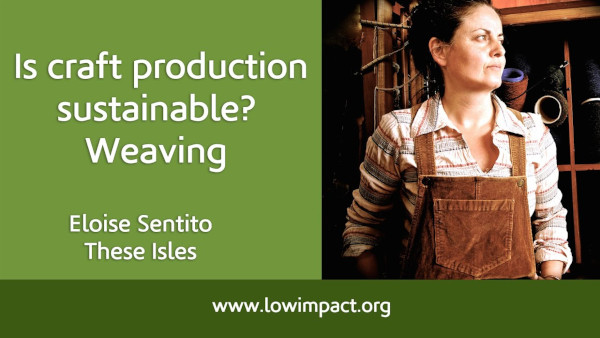
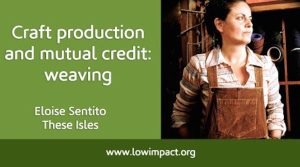
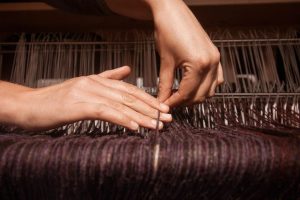
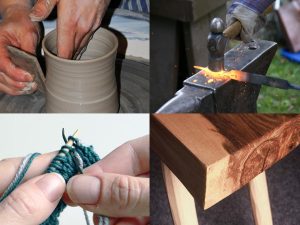
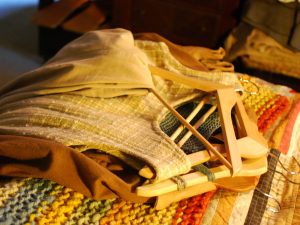
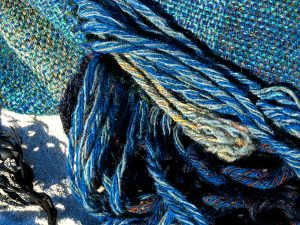
4 Comments
Thanks Dave. These Isles’ textiles sustainability ratings chart described is here: https://theseisles.co/sustainability
Dave, just a thought: these interviews (certainly those of mine) could benefit from some harsher editing (chopping out my waffle, as the hesitant bits are very boring)! 🙂
Hi Eloise. You’re definitely never boring, but I was thinking that I’d start to post slightly condensed versions of interviews, so that people can scan to see the main points made – then if people want to hear the full conversation they can watch the video.
Because I’m itinerant, my business is entirely reliant on my online shop, which is surely the epitome of industrial globalised capitalism, ouch. But since in our current monetary system that sucks wealth out of communities local craft is basically unaffordable to local people, an online shop offers makers and consumers a stepping stone: keep the craft skills alive and valued by joining the forces of the far flung maker and consumer to galvanise the movement. Etsy has worked well for me: it helps me reach kinfolk worldwide where otherwise a maker might only sell locally to the elite. And so I encourage any maker or would-be-maker to consider setting up shop there (with your eyes open): https://etsy.me/3lf6XOF